Baked Alaska: A Scrumptious Dessert Delight Covered in Browned Meringue

Baked Alaska, also known as glace au four or omelette norvegienne, is a show-stopping dessert that combines the contrasting elements of cold ice cream and warm meringue. This delightful treat features a layer of sponge cake topped with a dome of ice cream, all enveloped in a thick layer of toasted meringue. The magic happens when the dessert is briefly baked in a hot oven to brown the meringue while keeping the ice cream inside frozen. Baked Alaska is not just a dessert; it's an experience that delights both the eyes and the taste buds.
History and Origins of Baked Alaska
Baked Alaska, also known as "omelette norvégienne" in French, is a classic dessert that dates back to the 19th century. It is believed to have been created by Chef Charles Ranhofer at Delmonico's Restaurant in New York City in 1867 to commemorate the United States' acquisition of Alaska from Russia. The dessert was originally named "Alaska-Florida" to represent the contrasting hot and cold elements. Over time, it became popular at dinner parties and fine dining establishments, showcasing the innovative combination of ice cream encased in sponge cake and topped with meringue that is baked quickly at high heat to create a beautifully browned exterior while keeping the ice cream inside frozen.
Ingredients Required for Baked Alaska
Baked Alaska, a delightful dessert that combines cold ice cream with warm cake and a toasted meringue topping, requires a few key ingredients to come together harmoniously. To create this delectable treat, you will need sponge cake or genoise, your choice of ice cream flavors (traditionally vanilla, but feel free to experiment), and meringue made from egg whites and sugar. Optionally, you can add a splash of liqueur like Grand Marnier or rum to enhance the flavor profile. These simple yet essential ingredients are what make Baked Alaska a show-stopping dessert that is sure to impress your guests.
Step-by-Step Instructions on How to Make Baked Alaska
1. Start by preheating your oven to 450°F (230°C) and line a baking sheet with parchment paper.
2. Choose your favorite cake as the base, such as sponge cake or pound cake, and place it on the prepared baking sheet.
3. Scoop a generous amount of ice cream onto the cake, spreading it evenly to cover the entire surface.
4. Place the assembled cake and ice cream in the freezer for at least 30 minutes to firm up.
5. In a clean mixing bowl, whisk egg whites until stiff peaks form, gradually adding sugar to make meringue.
6. Remove the cake and ice cream from the freezer and quickly spread the meringue over them, ensuring no gaps are left.
7. Use a spatula to create decorative peaks in the meringue for an elegant finish.
8. Bake in the preheated oven for 3-5 minutes or until the meringue is lightly browned.

9. Serve immediately and enjoy this delightful combination of warm meringue, cold ice cream, and soft cake layers in every bite.
Tips and Tricks for Perfecting Baked Alaska
To ensure your Baked Alaska turns out perfectly, here are some tips and tricks to keep in mind. Firstly, make sure your ice cream is frozen solid before assembling the dessert to prevent it from melting too quickly in the oven. Secondly, when covering the ice cream with meringue, be sure to seal the edges completely to prevent any leakage. Additionally, using a piping bag to create decorative swirls on the meringue can result in a more visually appealing final product. Lastly, preheating your oven well and closely monitoring the baking process will help achieve that ideal golden brown color on the meringue without overcooking the dessert inside.
| Feature | Baked Alaska | Ice Cream Cake | Baked Meringue |
|---|---|---|---|
| Frozen Component | Ice Cream | Ice Cream | Typically None |
| Cake Base | Yes | Yes | No |
| Meringue | Yes, browned | Optional, not browned | Yes, browned |
| Serving Temperature | Cold | Cold | Warm or room temperature |
Serving Suggestions and Variations of Baked Alaska
Baked Alaska is a versatile dessert that can be customized to suit various tastes. One popular variation is to add a layer of raspberry or strawberry sauce between the cake and ice cream for a fruity twist. Another option is to drizzle chocolate sauce over the meringue before browning it for a decadent touch.
For serving, consider flambeing the meringue with a splash of rum or brandy for a dramatic presentation. You can also experiment with different ice cream flavors such as pistachio, coffee, or mint chocolate chip to create unique flavor combinations.
To elevate the dish further, serve slices of Baked Alaska with fresh berries, whipped cream, or a scoop of vanilla bean ice cream on the side. The contrast of warm meringue against cold ice cream makes for a delightful sensory experience that will impress your guests and leave them craving more.
In conclusion, Baked Alaska is a show-stopping dessert that combines the contrasting elements of cold ice cream and warm cake with a cloud-like meringue topping. Its origins date back to the 19th century, making it a classic dessert with a rich history. The key to a successful Baked Alaska lies in properly assembling and baking the components to achieve the perfect balance of textures and flavors. While it may seem daunting to make, with practice and attention to detail, anyone can master this impressive dessert. So next time you're looking to impress your guests or indulge in a decadent treat, consider trying your hand at making Baked Alaska - it's sure to be a hit!

Published: 12. 06. 2024
Category: Food



